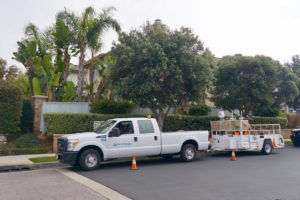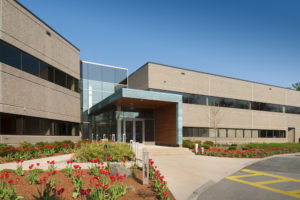Top 8 Things NOT to do in Commercial Landscape
Landscape is often one of the best and biggest investments you can make when it comes to your commercial property. It’s a guaranteed way to make your property more valuable, enhance overall visual appeal, make a positive, lasting impression – on both clients and employees – but, only if done right. Avoid these common commercial landscaping mistakes to ensure you’re getting the best return on your investment:
1. Plants Were Installed in the Wrong Place or at the Wrong Depth
The Problem:
Plants require certain conditions to thrive. If these considerations aren’t addressed prior to planting, they’ll suffer – incurring more long-term maintenance costs and possibly future renovations and/or plant replacement. For example, trees need a certain amount of air for roots to grow, so planting trees too deeply is one of the quickest ways to kill them. Unfortunately, we see this done all too often on sites we’ve taken over the maintenance.
The Solution:
Your landscape provider should establish a long-term plan for your property’s landscape to avoid future issues. The amount of sun or shade should be factored into plant placement, planting depth requirements, water needs, soil conditions, and location – you don’t want plants or trees that look great now but could interfere with structures, walkways, or cause property damage, once they reach full maturity. Work with your landscape maintenance contractor to establish a plan for plant placement that addresses both short-term and long-term goals. Always consider what the plant will look like at maturity, especially trees.
2. Picking the Wrong Kind of Plants for Your Property
The Problem:
There are several factors to consider when choosing plant palettes – including the overall design theme, what San Diego microclimate your property’s located in, the plants’ irrigation needs, budget requirements, avoiding disease-prone plants, and your property’s soil composition – just to name a few! If your landscape provider doesn’t have a good understanding of these critical property attributes, you could end up with plants that suffer and need extra maintenance or replacement.
The Solution:
The first step in any successful landscape plan is communication – between client and contractor. It’s so important that your landscape company understands the goals you have for your property when it comes to plant type and the overall look. It’s just as important for your landscaper to communicate the possibilities with you, taking all factors into account, so that realistic expectations are established from the beginning.
3. Mowing Turf Too Short
The Problem:
A well-manicured turf area is a focal point for commercial properties, and we all appreciate and clean look. So you may think, the shorter the better…right? Wrong. Cutting turf too short can actually make the grass more susceptible to patchiness, insect damage, and disease. It can even kill off certain types of turf.
The Solution:
Turf should be maintained at different heights throughout the year, depending on weather conditions. Because we have less dramatic change of seasons here in San Diego, your landscape maintenance provider will mow with slight variations in height – leaving turf a little taller in the summer so it gets adequate shade and a little shorter in the winter so that it gets adequate sunlight.
4. Fertilizing Too Much or Too Little
The Problem:
Over or under-fertilizing turf and plants is a common mistake in commercial landscape. Too much fertilizer can result in plant damage (aka fertilizer burn) while too little fertilizer can limit growth. There’s also a right time of year to use and not to use fertilizers; not all fertilizers work well year round.
The Solution:
Hire an experienced, licensed commercial contractor that’s an expert in plant care. Your landscape provider will provide you with a detailed, customized maintenance plan that includes a fertilization program. Slow-release fertilizers may be recommended, depending on your property’s needs – which offer a host of benefits including improved turf quality, less ongoing maintenance, reduced risk of fertilizer burn, and a lower environment impact.
5. Not Installing Mulch
The Problem:
For various reasons, maybe to cut costs or during seasonal shifts, you may have decided not to prioritize mulch applications or refreshments. This not only alters the appearance of your landscape and property (and not in a good way!), but leaves your landscape unprotected and can inhibit healthy plant growth.
The Solution:
Don’t skip the mulch! As part of your landscape maintenance plan, your provider will apply mulch on an as-needed basis to offer a layer of protection for plants and trees. Mulch is often an underrated element in landscaping, but it’s working hard to not only make your property look good, but also to help retain moisture, prevent weeds, add organic nutrients to the soil as it biodegrades, and aid in erosion control. If you really need to save on the mulch, consider adding a light layer of mulch (1” instead of 2” or more).
6. Not Skipping Mowing Operations After Rain
The Problem:
If turf is mowed too soon after periods of rain, the grass is more susceptible to damage and disease. Clippings aren’t dispersed evenly, causing them to clump – not exactly aesthetically pleasing, but also causes patchiness and/or brown spots in the turf. To top it all off, mowers can leave grass marks on sidewalks and pavement.
The Solution:
Your maintenance provider will most likely skip mowing operations after it rains to allow ample time for the turf and soil to dry. But this doesn’t mean maintenance stops! Your crews will use the “extra” time to tend to other areas of your property, often taking care of additional cleanup that’s usually needed after rainy weather.
7. Blowing the “Wrong” Way
The Problem:
Blowing too hard can push debris into other areas of the property.
The Solution:
“Smart blowing”: In most cases a blower is just as effective on a lower setting AND it results in a quieter visit from your landscape crew! As important as it is to blow on the right setting, direction is also important. Around front doors, entrances, porches, and shrub hedges bordering buildings – for example – landscapers should blow up, pushing the debris out rather than into other areas.
8. Improper Pruning
The Problem:
Over pruning is a common issue in landscape and can cause irreversible damage to some plants.
The Solution:
There’s a right and wrong way to cut! Proper pruning techniques will help maintain the health and appearance of trees and shrubs. The crews managing your property’s landscape will routinely inspect the condition of plants and remove dead limbs or trim back – as-needed and seasonally, and with proper cutting techniques. This improves the health of the landscape, increases safety, and keeps your property looking its best.
Have concerns about your property’s landscape? Let our experienced and knowledgeable team help! Reach out today for a property evaluation; Benchmark offers customized maintenance solutions designed to meet your goals and improve your property’s value!




